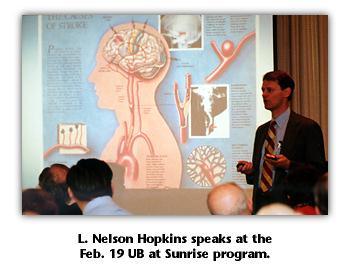
PHOTO BY DON HEUPEL

By LOIS BAKER
News Services Editor
He described an 18-month study he is conducting on the use of an intra-arterial clot-dissolving procedure, which so far has involved 22 stroke patients.
"Eight of those patients were brought back to normal or near normal," he said, a note of astonishment still in his voice. "They came in paralyzed and unable to talk. Administering the drug was like throwing a switch. It was amazing."
Hopkins, director of UB's new Toshiba Stroke Research Center, is an internationally known expert in the newest methods of dislodging blood clots and repairing aneurysms in the brain, the two main causes of stroke. He also is a vocal proponent of the medical establishment's initiative to instill the concept of "brain attack" in the public mind, and has been instrumental in developing quick-response protocols at area hospitals.
He wants the public to get this message: A stroke is a medical emergency equal in urgency to a heart attack. Learn the warning signs, and if you experience them, get to an emergency room immediately.
"We can reverse a stroke if we can dissolve the clot within the first six hours," Hopkins told the audience. "The brain is so hungry for oxygen and glucose that the cells will die if blood flow isn't restored within six hours. But if you wait longer than that, the damage can't be reversed."
A few years ago, thinking of stroke in this manner was irrelevant, he said, because physicians didn't know how to restore blood flow quickly. Now they can, using blood-clot-dissolving drugs and other procedures, aided by advanced imaging techniques that allow specialists to pinpoint precisely the location of the blockage. Drugs then are administered through a standard IV line, or as is Hopkins' specialty, via a miniature catheter threaded through an artery in the groin until it reaches the clot in the brain.
In addition to clot-dissolving drugs, other drugs work at the cellular level to prolong cell life and increase the window of opportunity to restore full blood flow, Hopkins said.
Treatments on the horizon include using lasers to "shake" the clot apart, and mechanical clot removers that can suck out a clot.
None of these treatments are risk-free, he noted, and not all patients can be saved from disability or death. Of the remaining patients in his 18-month study, six improved partially, five remained the same, and three died.
Improving the outcome of stroke is critical, because the cost in human lives and health care dollars is enormous, Hopkins said. He noted that:
· 550,000 people a year experience a stroke.Health-care professions face a major public-education challenge if they hope to change the nation's perceptions about stroke.· One-third recover, one-third die, one-third are "destroyed," living out their lives in nursing homes.
· Stroke is the leading cause of adult disability in the U.S.
· Strokes cost this nation $20 billion a year in direct and indirect costs.
Hopkins said 97 percent of the participants in a recent study couldn't name the symptoms of stroke, and less than 50 percent knew that the organ involved was the brain.
UB at Sunrise is a series of breakfast programs produced by the UB Alumni Association and UB's Office of Conferences and Special Events, News Services and Office of Publications. It also is supported by the Office of University Development and Office for Public Service and Urban Affairs. The Buffalo/Niagara Marriott is corporate sponsor.

PHOTO BY DON HEUPEL